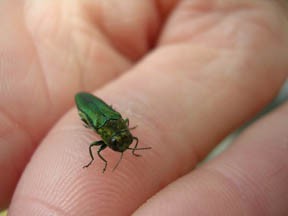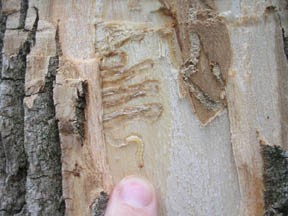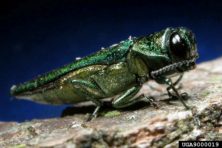Preparing for Emerald Ash Borer in Door County
- Share
- Tweet
- Pin
- Share
Door County Parks Director Erik Aleson called it one of the nicest forests in the Door County parks system, but protecting it could require cutting many of its trees.
That’s because 43 percent of Door Bluff Headlands County Park’s trees are ash trees, and susceptible to an infestation of a sparkly green invasive pest called the Emerald Ash Borer (EAB). The insect is making its way across the eastern U.S. and Great Lakes region, leaving scores of dead ash trees in its wake.
“We don’t know for sure if it’s going to be in the next three years, five years or 10 years, but from our indications after talking to foresters and experts about the insects it’s only going to be a matter of time until it comes up to Door County,” Aleson said.

Photo submitted by Bill McNee, Wisconsin DNR.
No EAB have been found in the county, but the nearest infestation is just 20 miles from the county line in the city of Green Bay.
The bugs can only move up to two miles a year on their own, but often hitchhike around the country on ash products.
“The problem is [when EAB moves] 55 mph down the road in the back of a pickup in infested firewood,” county forester Bill Ruff said.
EAB came to the U.S. from Asia on shipping crates. They were first seen in Michigan about 20 years ago, and have since spread as far as Georgia and Colorado, according to the U.S. Department of Agriculture.
When the bugs come through there’s almost no stopping them, trees are dead within six years of an infestation. Routinely injecting trees with insecticide could save them from EAB, but Ruff said that isn’t practical for a forest like Door Bluff Headlands.

EAB larvae leave these tracks in ash trees, underneath the tree bark. The tracks block food and water from flowing through the tree. Photo submitted by Bill McNee, Wisconsin DNR.
“We’re in a mode of trying through normal thinning or harvesting to reduce that ash component and favor other trees in the stand,” Ruff said. “For those stands that are really heavily populated with ash you don’t have a lot of options.”
The goal would be to take the percentage of ash trees in Door Bluff Headlands park from 43 percent to less than 20 percent, which would give other tree species the chance to fill in the gaps, give the parks department a chance to harvest and sell the timber while it’s still good and save the park from a future where almost half of its trees die at once.
“We want to make the park safe for the road and picnic area, and make sure there aren’t trees falling over the road, damaging vehicles or worse yet, injuring somebody,” Aleson said. “If we could thin out a portion of [the park] – we’re not talking about doing a large-scale, wiping out of all the ash trees in the forest there, but reducing it to a 20 or 25 percent level.”
To discuss the future of Door Bluff Headlands County Park, the Door County Parks Committee will meet at the Liberty Grove Town Hall on Thursday, Feb. 20, at 6 pm for its regular monthly meeting.
The committee will consider public comments and follow the DNR’s forest management plan for the county and factor in its recommendations to deal with EAB. Aleson expects to bid the project in time to harvest Door Bluff Headlands’ trees next winter.

